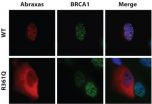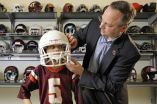When: February 25-29, 2012
Where: The Manchester Grand Hyatt Hotel, San Diego, California, USA
Additional Information: Research topics to be presented by NIDCD-funded scientists will include:
Bilateral ≠ Binaural: Can the Ability to Localize Sounds Be Regained After Bilateral Cochlear Implantation?
Ruth Litovsky, Ph.D., University of Wisconsin-Madison
Bilateral cochlear implants—one implant for each ear—are becoming more common as a treatment for children who are deaf or hard-of-hearing. Many children with cochlear implants attain spoken language skills that are comparable to their hearing peers, but even with two implants children often appear to perform significantly worse on tasks that involve hearing in complex listening environments (a busy classroom, for example) where they need to distinguish a teacher's or classmate's voice from competing background noise. According to NIDCD-grantee Ruth Litovsky, Ph.D., this is a function of the difference between how cochlear implants and the natural hearing ear process sound. Cochlear implants have not been designed to provide binaural cues—the cues that two normal ears provide to the brain. Binaural cues help listeners localize (know where the sound happens) and segregate (identify the meaning of a sound source) incoming sounds. In normal hearing, each ear sends its own unique information up the auditory pathway to the brainstem, and specialized neurons are able to decode the timing and intensity difference between sounds at the two ears to establish location and meaning. Cochlear implants don't provide the same kind of coordinated information to the brain. Dr. Litovsky's lab is working with three different groups of children and adults with bilateral cochlear implants to learn more about the binaural pathway in the brain. The investigators are working with a desktop research processor that attempts to recapture lost binaural cues by using a microphone in each ear and combining both streams of information, which it then sends back to each cochlea. The researchers are hoping that this technique will offer a way to preserve acoustic cues that are currently degraded because of lack of coordination between the two implants.
The Presidential Symposium, "Listening with the Brain: Cochlear Implants and Central Auditory System Plasticity," takes place on Saturday, Feb. 25, 8:00 a.m.:00 p.m. in the Elizabeth Ballroom
Spotlight on Spiral Ganglion Cells— New Research in Regeneration
Alain Dabdoub, Ph.D., University of California School of Medicine, San Diego (organizer);
Robin Davis, Ph.D., Rutgers University; Albert Edge, Ph.D., Harvard Medical School, Massachusetts Eye and Ear Infirmary; Bernd Fritzsch, Ph.D., University of Iowa (among the presenters)
Spiral ganglion neurons (SGNs) transmit sound information in the form of electrical signals from the sensory cells in the inner ear, called hair cells, to the cochlear nucleus of the brainstem. Once lost due to noise or aging, SGNs and hair cells in mammals are never recovered. The most common therapies for hearing loss either use hearing aids to increase hair cell stimulation or use cochlear implants as an electronic substitute for damaged hair cells, but both therapies depend on the presence of functional SGNs. However, recent evidence shows that exposure to loud noise over time can lead to hearing loss caused not by damage to hair cells, but by loss of SGNs, and interest is rising in looking at strategies for replacing damaged or missing SGNs in the cochlea. This symposium features presentations from some of the most prominent investigators in the field of SGN regeneration, whose findings could play a significant role in future advances in cochlear implant technology and the medical treatment of hearing loss and deafness. Dr. Bernd Fritzsch will share findings from his laboratory, where they are elucidating the molecular mechanisms that regulate hair cell and SGN formation, particularly the factors that appear to regulate the growth and guidance of SGN fibers. Dr. Robin Davis will describe the diversity of organization, protein expression, and electrophysiological characteristics of neurons in the SGN family—not all SGNs are alike. Dr. Albert Edge will discuss his laboratory's efforts to generate SGNs using mouse embryonic stem cells and to reconnect healthy hair cells to the stem cell-derived neurons. Dr. Dabdoub will also be discussing how he and his colleagues are working to reprogram cochlear non-sensory epithelial cells to become functional SGNs.
The symposium, "The Spiral Ganglion: Neurogenesis and Concepts for Regeneration," takes place on
Saturday, Feb. 25, 2:00 p.m.:35 p.m. in the Elizabeth Ballroom
Auditory Training of Older Adults Improves Speech Understanding in Noisy Environments
Samira Anderson, Au.D., Northwestern University
As we age we tend to have difficulty hearing in crowds and in other noisy environments, which isn't entirely the result of age-related hearing loss. There are also age-related changes in the neural circuits of the brain in coding the rapidly-changing speech signal, which make it much more difficult to follow speech in background noise. Amplifying sound, which is what hearing aids do, does not restore the precise neural timing needed for speech perception. Samira Anderson, Au.D., a graduate student at Northwestern University, and her colleagues have been working with older adults using a commercially available cognitive-based auditory training program to determine if intensive auditory training can improve temporal processing and increase speech-in-noise performance. Participants are older adults (ages 58 to 65) with normal to mild hearing loss, who were randomly assigned to one of two treatment groups. The experimental group completed eight weeks of cognitive-based auditory training, the control group completed eight weeks of general interest education training, and a third group received no training. Ms. Anderson will be discussing the results of the study, which showed significant improvements in the ability of the auditory trained group to process the time-changing speech signal and to understand speech in noisy environments. The findings offer a method of treatment, above and beyond sound amplification, to improve the hearing abilities of older adults.
The poster "Neural precision with auditory training in older adults," takes place from Saturday, Feb. 25 at 1:00 p.m. to Sunday, Feb. 26, at 12:00 p.m. in the Manchester Ballroom
Novel Photokinetic Transducer Technology Drives New, Experimental Hearing Device
Sunil Puria, Ph.D., EarLens Corporation and Stanford University
In this podium presentation, Dr. Sunil Puria will be presenting findings from a recent small FDA-approved clinical trial. The trial tested a new class of hearing device that applies vibrations directly to the eardrum, rather than amplifying sound in the ear canal, to improve hearing in noise and sound quality. The EarLens Photokinetic transducer prototype uses a small solar cell that turns light pulses into the energy needed to remotely drive the motor and avoids the need for a hardwired connection, found in other surgically implanted systems. A key technical advantage is that the Photonic Hearing Device has a 10 kHz bandwidth, while acoustic hearing aids are limited to about 5 kHz. Subjects in the trial were fitted with the device and exposed to four different hearing conditions using noise and speech maskers to simulate difficult listening environments. Results indicate an improvement in hearing in noisy situations. EarLens Corporation, the developer of the prototype device, is planning to build a more refined clinical prototype for a multicenter clinical trial.
The podium presentation "The EarLens Photonic Hearing Aid," takes place on Monday, Feb. 27, 11:45 a.m.:00 p.m. in the Elizabeth Ballroom
Steroid Treatments in the Inner Ear Impact Thousands More Genes than Expected
Dennis Trune, Ph.D., M.B. A., Oregon Health & Science University
Corticosteroids, usually in the form of prednisone, prednisolone, or dexamethasone, have become the treatment standard for sensorineural hearing loss. However, little is known about how steroids work in the inner ear to restore hearing. The prevailing view has been that steroids reduce inflammation, which is believed to be what causes the hearing loss. In previous studies, Dr. Trune's laboratory has shown in mice that although steroids do suppress circulating inflammatory factors, their key function in restoring hearing appears to be in turning on genes involved in maintaining the proper concentration of potassium and sodium ions in the endolymph, a fluid contained in the inner ear. These studies also showed that, in spite of having no anti-inflammatory properties, the mineralocorticoid aldosterone (a naturally occurring steroid hormone) can also activate the genes responsible for ion balance and recover hearing. Taking advantage of an NIDCD supplemental grant, Dr. Trune and his colleagues have used gene chip technology to scan the entire mouse genome to establish the full array of inner ear genes that are switched on or off by traditional steroid treatments versus aldosterone treatment. In light of recent clinical activities—which favor a local injection of steroids to the middle ear to lower the risk for the side effects that accompany systemic steroid use—they treated either systemically or by injection across the eardrum (transtympanic). Dr. Trune will be discussing the findings of the genome scan, which indicate that steroids turn on or off 55 to 82 percent of the approximately 17,500 genes that are expressed in the inner ear. In addition, these numbers increase significantly when steroids are delivered transtympanically. These findings could offer a way to finetune sensorineural hearing loss treatments to target ion balance pathways instead of immunosuppressive pathways.
The podium presentation "Transtympanically Delivered Steroids Impact Thousands of Inner Ear Genes over Conventional Systemic Delivery," takes place on Tuesday, Feb. 28, 11:45 a.m. in the Elizabeth Ballroom
INFORMATION:
For more information about the Association for Research in Otolaryngology, visit their website at www.aro.org.
NIDCD supports and conducts research and research training on the normal and disordered processes of hearing, balance, taste, smell, voice, speech and language and provides health information, based upon scientific discovery, to the public. For more information about NIDCD programs, see the website at www.nidcd.nih.gov.
About the National Institutes of Health (NIH): NIH, the nation's medical research agency, includes 27 Institutes and Centers and is a component of the U.S. Department of Health and Human Services. NIH is the primary federal agency conducting and supporting basic, clinical, and translational medical research, and is investigating the causes, treatments, and cures for both common and rare diseases. For more information about NIH and its programs, visit www.nih.gov.
NIH—Turning Discovery Into Health
END

